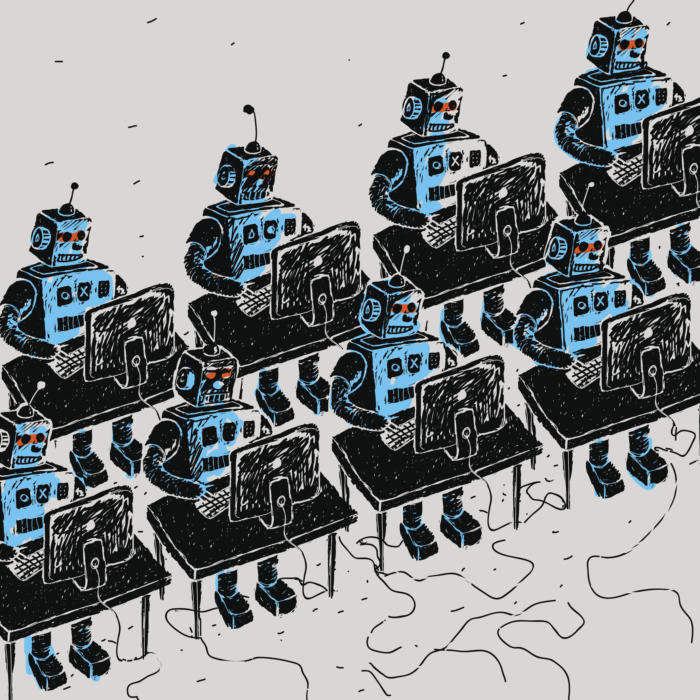For as long as labor has existed, there has been a fear that technology will kill jobs. Scribes were pissed at the printing press. Lumberjacks and weavers thought life was over after the creation of mechanical axes and looms. Yet, life and labor have gone on.
copyright by www.cio.com
 Not only has life continued, it’s thrived. By all measures – life expectancy, child mortality, basic education and access to information, food security, etc. – life for humans is better than ever . This is a direct result of technological innovation.
Not only has life continued, it’s thrived. By all measures – life expectancy, child mortality, basic education and access to information, food security, etc. – life for humans is better than ever . This is a direct result of technological innovation.
But for many, artificial intelligence (AI) presents a threat humankind has never faced before. As they see it, for the first time the human reasoning and decision making can actually be replaced and improved upon by this new technology. They argue that the promise of AI thinking and problem solving like humans removes the need for humans to be a part of the labor process. It will be the collapse of human labor production as we know it.
Without question, how work gets done is changing. However, the overall impact of this change will be the exact opposite of doom and gloom. Based on all indications, AI will spur the largest economic growth since the Industrial Revolution. By supporting this growth, human labor will benefit in three key ways.
More pie
AI will “grow the pie” with a two-prong economic growth effect.
First, and most specifically related to the supply chain, AI will increase the velocity of trade. Goods will be moving more and sitting less, with their path from raw materials to consumers streamlined and more precise. With AI’s help, the supply chain can move more products to more customers and at a lower cost by removing the waste from production and distribution. By removing friction from the supply chain, the entire ecosystem is more adaptive and can adjust to accommodate market or consumption changes faster. This stabilizes markets and will moderate the effects of traditional downturns to support further growth.
Secondly, AI will create new categories that not only stimulate consumption, but facilitate ancillary markets. While many of the new categories and markets will remain a mystery until AI has reached a certain level of maturity (who predicted GPS-guided smartphone-enabled ride sharing in 1980?), we can look at a recent example of innovation that had a comparative effect. […]
read more – copyright by www.cio.com
Thank you for reading this post, don't forget to subscribe to our AI NAVIGATOR!


For as long as labor has existed, there has been a fear that technology will kill jobs. Scribes were pissed at the printing press. Lumberjacks and weavers thought life was over after the creation of mechanical axes and looms. Yet, life and labor have gone on.
copyright by www.cio.com
But for many, artificial intelligence (AI) presents a threat humankind has never faced before. As they see it, for the first time the human reasoning and decision making can actually be replaced and improved upon by this new technology. They argue that the promise of AI thinking and problem solving like humans removes the need for humans to be a part of the labor process. It will be the collapse of human labor production as we know it.
Without question, how work gets done is changing. However, the overall impact of this change will be the exact opposite of doom and gloom. Based on all indications, AI will spur the largest economic growth since the Industrial Revolution. By supporting this growth, human labor will benefit in three key ways.
More pie
AI will “grow the pie” with a two-prong economic growth effect.
First, and most specifically related to the supply chain, AI will increase the velocity of trade. Goods will be moving more and sitting less, with their path from raw materials to consumers streamlined and more precise. With AI’s help, the supply chain can move more products to more customers and at a lower cost by removing the waste from production and distribution. By removing friction from the supply chain, the entire ecosystem is more adaptive and can adjust to accommodate market or consumption changes faster. This stabilizes markets and will moderate the effects of traditional downturns to support further growth.
Secondly, AI will create new categories that not only stimulate consumption, but facilitate ancillary markets. While many of the new categories and markets will remain a mystery until AI has reached a certain level of maturity (who predicted GPS-guided smartphone-enabled ride sharing in 1980?), we can look at a recent example of innovation that had a comparative effect. […]
read more – copyright by www.cio.com
Thank you for reading this post, don't forget to subscribe to our AI NAVIGATOR!
Share this: